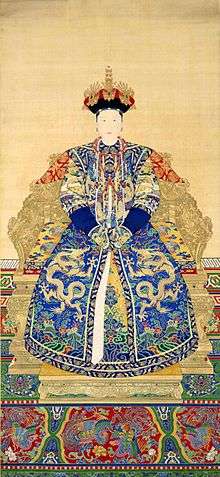Empress Xiaokangzhang
| Empress Xiaokangzhang | |||||
|---|---|---|---|---|---|
| Empress of the Qing dynasty | |||||
 | |||||
| Born | 1640 | ||||
| Died |
20 March 1663 (aged 22–23) Beijing, China | ||||
| Spouse | Shunzhi Emperor | ||||
| Issue | Kangxi Emperor | ||||
| |||||
| House |
Tunggiya (by birth) Aisin Gioro (by marriage) | ||||
| Father | Tong Tulai | ||||
| Empress Xiaokangzhang | |||||||
| Chinese name | |||||||
|---|---|---|---|---|---|---|---|
| Chinese | 孝康章皇后 | ||||||
| |||||||
| Lady Tunggiya | |||||||
| Chinese | 佟佳氏 | ||||||
| |||||||
| Manchu name | |||||||
| Manchu script | ᡥᡳᠶᠣᠣᡧᡠᠩᡤᠠ ᠨᡝᠰᡠᡴᡝᠨ ᡝᠯᡩᡝᠮᠪᡠᡥᡝ ᡥᡡᠸᠠᠩᡥᡝᠣ | ||||||
| Romanization | hiyoošngga nemgiyen eldembuhe hūwangheo | ||||||
Empress Xiaokangzhang (Manchu: Hiyoošungga Nesuken Eldembuhe Hūwangheo; 1640 – 20 March 1663) was a consort of the Shunzhi Emperor of the Qing dynasty. Since she was the birth mother of the Shunzhi Emperor's third son and successor, the Kangxi Emperor, she was posthumously honoured as an Empress.
Life
Empress Xiaokangzhang's original family name was Tong (佟).[1] Her personal name was not recorded in history. Although her family was of Jurchen descent, they had lived among Han Chinese for many generations and had been assimilated into Han Chinese society in Fushun, Liaoning, during the Ming dynasty, hence they were regarded as nikan (Han Chinese) by the Manchus and placed under a Han banner instead of a Manchu banner.
Lady Tong's father was Tong Tulai (佟圖賴; 1606–1658), a military leader. Her grandfather was Tong Yangzhen (佟養真; d. 1621). She had two brothers – Tong Guogang (佟國綱; d. 1690) and Tong Guowei (佟國維; d. 1719). Her clan was originally under the Han Chinese Plain Blue Banner, but was later moved to the Manchu Bordered Yellow Banner after her son became the Emperor. Her family name was also changed from "Tong" to the Manchu-sounding "Tunggiya".
Lady Tunggiya entered the Forbidden City and became an ordinary concubine of the Shunzhi Emperor. She never received any title or rank during the Shunzhi Emperor's reign. In 1654, she bore the Shunzhi Emperor his third son, Xuanye. When the Shunzhi Emperor died in 1661, Xuanye was chosen to be the new emperor and was enthroned as the Kangxi Emperor. As the birth mother of the reigning emperor, Lady Tunggiya was honoured as Empress Dowager under the title "Empress Dowager Cihe" (慈和皇太后).
Lady Tunggiya died on 20 March 1663 in the Forbidden City. Her death was reportedly due to an unknown illness but the circumstances surrounding her death were suspicious.[2] Although she had never been Empress during the reign of the Shunzhi Emperor, she was posthumously honoured as "Empress Xiaokangzhang" by the Kangxi Emperor. She was interred in the Fuling Mausoleum alongside the Shunzhi Emperor and Empress Xiaoxianduanjing.
See also
Notes
References
- Ho, Chuimei; Bronson, Bennet (2004). Splendors of China's Forbidden City: The Glorious Reign of Emperor Qianlong (Illustrated ed.). Merrell. ISBN 1858942039.
- Rawski, Evelyn S. (1998). The Last Emperors: A Social History of Qing Imperial Institutions (Reprint ed.). University of California Press. ISBN 052092679X.
- Ropp, Paul Stanley; Zamperini, Paola; Zurndorfer, Harriet Thelma (2001). Passionate Women: Female Suicide in Late Imperial China (Reprint ed.). BRILL. ISBN 9004120181.
- Wan, Yi; Shuqing, Wang; Yanzhen, Lu; Scott, Rosemary E. (1988). Daily Life in the Forbidden City: The Qing Dynasty, 1644-1912 (Illustrated ed.). Viking. ISBN 0670811645.
- Wu, Silas H. L. (1979). Passage to power: K'ang-hsi and his heir apparent, 1661-1722 (Illustrated ed.). Harvard University Press. ISBN 0674656253.
- Zhao, Erxun (1928). Draft History of Qing (Qing Shi Gao) (in Chinese).
| Chinese royalty | ||
|---|---|---|
| Preceded by Empress Dowager Xiaozhuang |
Empress Dowager of China 1661–1663 |
Succeeded by Empress Xiaohuizhang |
| Preceded by Empress Xiaohuizhang |
Empress of China Posthumous |
Succeeded by Consort Donggo (Empress Xiaochengren actual living successor) |